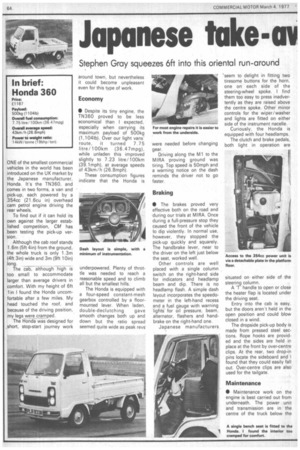Japanese take-av
Page 70

Page 71

If you've noticed an error in this article please click here to report it so we can fix it.
Stephen Gray squeezes oft into this oriental run-around
ONE of the smallest commercial vehicles in the world has been introduced on the UK market by the Japanese manufacturer, Honda. It's the TN360, and comes in two forms, a van and pick-up, each powered by a 354cc (21.6cu in) overhead cam petrol engine driving the rear wheels.
To find out if it can hold its own against the larger established competition, CM has been testing the pick-up version.
Although the cab roof stands 1.6m (5ft 41n) from the ground, the whole truck is only 1 .3m (4ft 3m) wide and 3m (9ft 1 Din) long.
The cab, although high is too small to accommodate larger than average drivers in comfort. With my height of 6ft 1 in I found the Honda uncomfortable after a few miles. My head touched the roof, and because of the driving position, my legs were cramped.
The Honda was designed for ,short, stop-start journey work around town, but nevertheless it could become unpleasant even for this type of work
Economy • Despite its tiny engine, the TN360 proved to be less economical than I expected, especially when carrying its maximum payload of 500kg (1 , 1 041b). Over our light vans'
route, it turned 7,75 litre/100km (36.47mpg), while unladen this improved slightly to 7.23 litre/100km (39.1mph), at average speeds of 43km/h (26.8mph).
These consumption figures indicate that the Honda is underpowered. Plenty of throttle was needed to reach a reasonable speed and to climb all but the smallest hills.
The Honda is equipped with a four-speed constant-mesh gearbox controlled by a floormounted lever. When laden, double-declutching gave smooth changes both up and down but the ratio spread seemed quite wide as peak revs were needed before changing gear.
Driving along the M1 to the MIRA proving ground was tiring. Top speed is 50mph and a warning notice on the dash reminds the driver not to go faster.
Braking
• The brakes proved very effective both on the road and during our trials at MIRA. Once during a full-pressure stop they caused the front of the vehicle to dip violently. In normal use, however, they stopped the pick-up quickly and squarely. The handbrake lever, near to the driver on the left just below the seat, worked well.
Other controls are well placed with a single column switch on the right-hand side for indicators and headlamp beam and dip. There is no headlamp flash. A simple dash layout incorporates the speedometer in the left-hand recess and a fuel gauge with warning light Sfor oil pressure, beam, alternator, flashers and handbrake on the right-hand one.
Japanese manufacturers 'seem to delight in fitting two tiresome buttons for the horn, one on each side of the steering-wheel spoke. I find them too easy to press inadvertently as they are raised above the centre spoke. Other minor controls for the wiper/washer and lights are fitted on either side of the instrument nacelle.
Curiously, the Honda is equipped with four headlamps.
The clutch and brake pedals, both light in operation are situated on either side of the steering column.
A 'T' handle to open or close the heater flap is located under the driving seat.
Entry into the cab is easy, but the doors aren't held in the open position and could blow closed in a wind.
The dropside pick-up body is made from pressed steel sections. Rope hooks are provided and the sides are held in place at the front by over-centre clips. At the rear, two drop-in pins locate the sideboard and I found that they could easily fall out. Over-centre clips are also used for the tailgate.
Maintenance
• Maintenance work on the engine is best carried out from underneath. The power unit and transmission are in the centre of the truck below the
A single bench seat is fitted to the Honda. I found the interior too cramped for comfort.
load platform but a lift-up cover in the platform doesn't afford sufficient access.
A dipstick is reached from the nearside in front of the rear wheel. Care must be taken not to catch one's hand on the nearby rope hooks. Battery electrolyte can be checked through an inspection slot in the exterior cover as the battery is of the see-through type
Summary • An engine of only 3 54cc (2 1.6cu in) isn't large enough to propel a vehicle with a payload potential of half a ton -at least not for long. If operators use the vehicle consistently at its gvw Honda should do a roaring trade in replacement units. But if its used, as I'm sure Honda intends, as an urban delivery truck carrying light loads it may suit many operators. Certainly with a price tag of £1,187 it will suit many pockets.


























































































































































